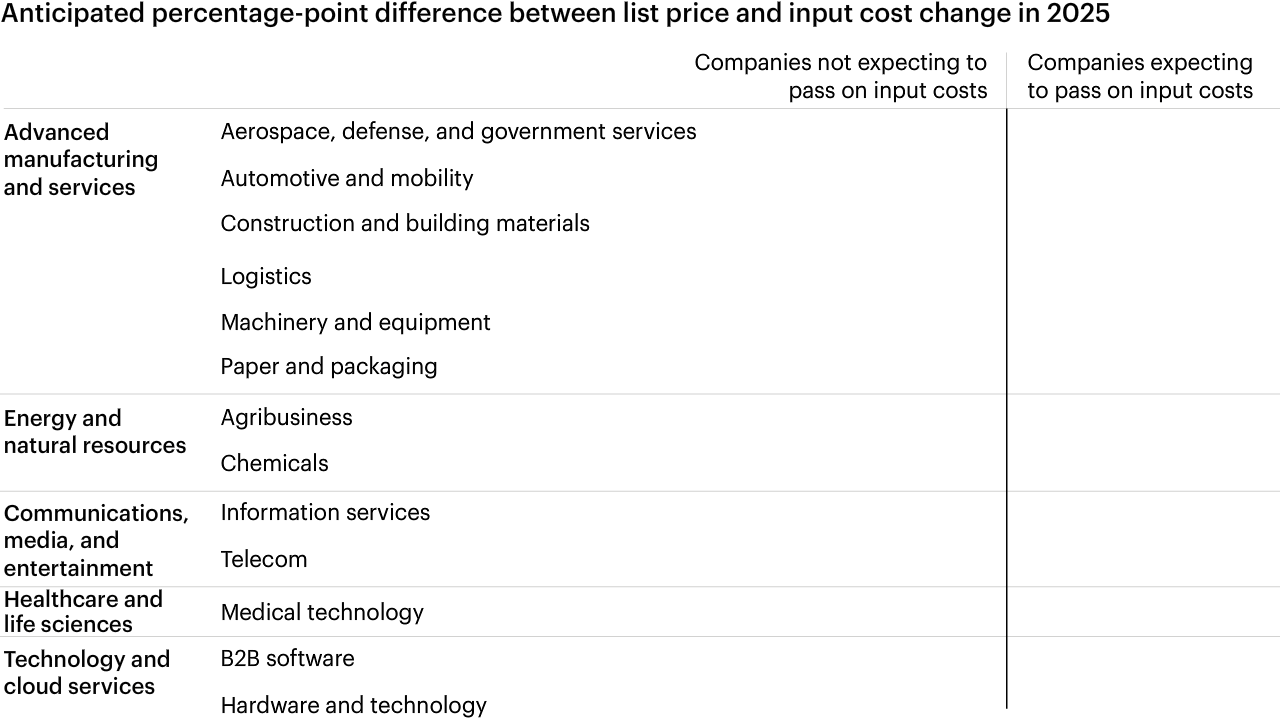Commercial Excellence Agenda

En Bref
- Cost inflation has steadied, enabling 55% of companies to match or exceed input cost hikes with price increases.
- However, companies cite competitive pressures and lack of sufficient data analytics as barriers to margin-enhancing pricing.
- For companies confident that they will push through price increases in 2025, the resulting profit margin premium is 3 percentage points.
- Almost all firms are investing in AI for pricing intelligence, but the leaders also focus on frontline training to build a distinctive value story.
This article is part of Bain's 2025 Commercial Excellence and Revenue Growth Agenda.
Cost inflation stabilized in 2024 throughout business-to-business (B2B) markets, and more companies were able to pass through cost increases in their prices. Increases in list prices surpassed or were equal to increases in input costs across 55% of the companies surveyed by Bain & Company.
Companies in most industries anticipate raising prices more closely in line with rising costs than in previous years, indicating a renewed focus on profit margin preservation or expansion (see Figure 1).
Pushing through pricing barriers to spur margin expansion
However, companies are worried about their ability to continue executing margin-enhancing pricing strategies in the absence of high inflation as the default justification for price increases. Competitive pressures, customer resistance, and other market challenges compose the biggest barrier, cited by 67% of respondents. The next most common barriers cited by respondents are insufficient data or analytics capabilities to support pricing decisions and gaps in team skills or expertise related to pricing, at 39% and 37%, respectively.
For companies confident in their ability to push through price increases in 2025, the premium in expected profit margin performance relative to other firms in the same industry is significant: The gap in margin performance between the two groups ranges from 5 to 11 percentage points (see Figure 2).


How leaders bridge the confidence gap
Virtually all respondents are investing in technology infrastructure and data to accelerate their deployment of artificial intelligence (AI) that powers strategic pricing. Most prevalent are technologies that allow companies to access competitor benchmarks and to actively segment customers for tailored prices or discounts.
Besides technology, we are seeing pricing leaders do a few other things differently. They are establishing a clear value story aligned with pricing that sets them apart from competitors. To develop a credible story, 52% of companies that expect to raise prices say they will use more frontline training to ensure that sellers can better articulate their unique value proposition that merits a price premium.
A sustained program to develop technology capabilities in pricing is well worth pursuing. In an earlier Bain survey of pricing decision makers, we found that organizations relying on data-driven guidance and analytics are more confident in negotiating their final price, and they report winning more deals than they lose at a 12% higher rate than other companies. Sales reps and managers who have dynamic data-driven guidance were almost twice as likely to say that they were confident in realizing price increases. All of these factors enhance revenue and profit margins.
Many commercial executives understand that pricing has a powerful impact on the bottom line, so gaining flexibility through tools that support precision pricing opens huge opportunities for improving profitable growth. Companies that greatly improve their technological capabilities, including in AI, and their frontline training, should be able to outpace rivals by more quickly adapting to industry and customer dynamics.
Read our 2025 Commercial Excellence and Revenue Growth Agenda
Explore the Report